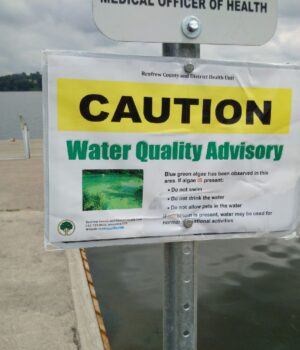Amanda Montgomery, Counsel for the Canadian Environmental Law Association
Reprinted from Blog with Permission
Provided by DW Deer
COBDEN – Every once in a while, the public alerts CELA to an environmental issue of which we were not aware. The extraordinary situation of Muskrat Lake in Renfrew County is one such example.
Late in 2019, the Muskrat Lake Association approached CELA for support in addressing the poor water quality of Muskrat Lake. The group was perplexed by the results of a Request for Review it had submitted as per the Environmental Bill of Rights, 1993, and was looking for guidance as to how to proceed. The group’s confusion was reasonable: despite the fact that the water quality of Muskrat Lake is among the worst in Ontario, the Ministry of the Environment, Conservation and Parks concluded that sufficient laws, regulations and policies already exist to protect the lake.
As it turns out, the state of Muskrat Lake is an open secret. Since at least the early 1980s, local and provincial authorities have recognized that the water quality of the lake is the poorest in Renfrew County.
Muskrat Lake has very high levels of phosphorus, largely due to manure and fertilizer run-off from numerous small agricultural operations throughout the watershed. Consequently, Muskrat Lake experiences excessive algal growth and oxygen depletion, increasingly rendering the lake unfit for any use, whether by fish or by humans.
Most worryingly, Muskrat Lake is the drinking water source for residents around the lake, including the Village of Cobden in the Township of Whitewater Region. However, Cobden’s municipal drinking water system, which supplies approximately 1,000 people, is not covered by the Clean Water Act.
The Clean Water Act legislates source water protection, a critical aspect of Ontario’s multi-barrier approach to drinking water protection that resulted from the Walkerton Inquiry. The Act contains mechanisms and regulations that prevent contaminants from entering sources of drinking water in the first place, such as aquifers or lakes.
But the Act only applies where there is an existing Conservation Authority, to areas designated by the province, or where a municipality has opted in. Currently, approximately 95% of Ontarians live in one of Ontario’s 19 source water protection areas. While this statistic might seem reassuring, it means that upwards of 700,000 people in Ontario don’t have appropriate drinking water protections.
The Village of Cobden is part of that 5%. Although the municipal system must meet provincial drinking water standards, there is no source water protection plan or coordinated oversight to prevent or address the pollution of Cobden’s source water, Muskrat Lake. This gap is particularly alarming given that Muskrat Lake is subject to regular blooms of blue green algae, which can produce a potentially fatal toxin that is difficult to remove from drinking water, even by municipal treatment systems.
Unfortunately, the Village of Cobden is not alone. CELA has since identified over 40 municipal drinking water systems throughout Ontario that are not covered by the Clean Water Act and, therefore, do not have source water protection plans to prevent the contamination of their sources of drinking water.
Muskrat Lake is a stark reminder that although Ontario has made great strides since the Walkerton tragedy, the work to ensure the safety of drinking water will not be complete until the source water of all Ontarians – including all of Ontario’s small towns and First Nations systems (which we’ll speak to in another blog) – is effectively protected.







![Kenopic/Smith Auction [Paid Ad]](https://whitewaternews.ca/wp-content/uploads/2018/10/advertising-100x75.jpeg)

